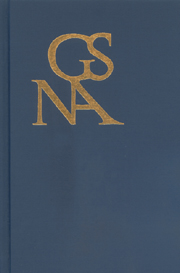Book contents
- Frontmatter
- Contents
- Illustrations
- Special section on childhood edited by Anthony Krupp
- Natural Palingenesis: Childhood, Memory, and Self-Experience in Herder and Jean Paul
- The Promises of Childhood: Autobiography in Goethe and Jean Paul
- The Education of Humankind: Perfectibility and Discipline in Kant's Lectures Über Pädagogik
- Kästchenwahl
- Sentimental Confusion: Art, Nature, and Aesthetic Autonomy in Goethe's Der Triumph der Empfindsamkeit
- Seeing the Light: Goethe's Märchen as Science—Newton's Science as Fairy Tale
- The Ironic “Tick” in Goethe's Egmont:The Potentials and Limits of the Modern Heroic and Poetic Ideal
- The Philosophical Concept of the Daemonic in Goethe's “Mächtiges Überraschen”
- “Die pilgernde Törin”: Genesis, Revaluation, and Mirroring in Goethe's Wanderjahre
- Book Reviews
Seeing the Light: Goethe's Märchen as Science—Newton's Science as Fairy Tale
from Special section on childhood edited by Anthony Krupp
Published online by Cambridge University Press: 05 February 2013
- Frontmatter
- Contents
- Illustrations
- Special section on childhood edited by Anthony Krupp
- Natural Palingenesis: Childhood, Memory, and Self-Experience in Herder and Jean Paul
- The Promises of Childhood: Autobiography in Goethe and Jean Paul
- The Education of Humankind: Perfectibility and Discipline in Kant's Lectures Über Pädagogik
- Kästchenwahl
- Sentimental Confusion: Art, Nature, and Aesthetic Autonomy in Goethe's Der Triumph der Empfindsamkeit
- Seeing the Light: Goethe's Märchen as Science—Newton's Science as Fairy Tale
- The Ironic “Tick” in Goethe's Egmont:The Potentials and Limits of the Modern Heroic and Poetic Ideal
- The Philosophical Concept of the Daemonic in Goethe's “Mächtiges Überraschen”
- “Die pilgernde Törin”: Genesis, Revaluation, and Mirroring in Goethe's Wanderjahre
- Book Reviews
Summary
Introduction: A Fairy Tale of Science Written in the “Symbols” of Nature
Light permeates Goethe's enigmatic 1795 Märchen, appearing in such manifold forms and reflections that it may come as a surprise that it refers rather straightforwardly to, well, light. Most interpretations of this tale begin with disclaimers about how its opulence renders it luminous with meaning and yet ultimately and intentionally opaque; I begin instead with the assertion of clarity. The play of light in this text mirrors many aspects of Goethe's critique of Newtonian optics. While the lights of the fairy tale may also reflect scores of ideas including the shine of poetry or aesthetics, the Schein of Schiller's Ästhetische Briefe, the enlightenment, theater lights, and the French Revolution described in its framing tale, Unterhaltungen deutscher Ausgewanderten, their primary role is to highlight, as it were, the role of light in the perception and interpretation of phenomena. Light in Das Märchen is the concrete, scientific topic with which Goethe was obsessed for much of his career, through which he felt he had accomplished far more than in any of his literary works, and on which he was actively working during the writing of his fairy tale. Goethe sees light as a complex problem whose very nature, as well as our mode of perceiving it, must be completely reassessed. Rather similarly to discussions in phenomenology and contemporary physics, he believed that perception and nature are not two separate subjects but rather always connected.
- Type
- Chapter
- Information
- Goethe Yearbook 14 , pp. 103 - 128Publisher: Boydell & BrewerPrint publication year: 2007



